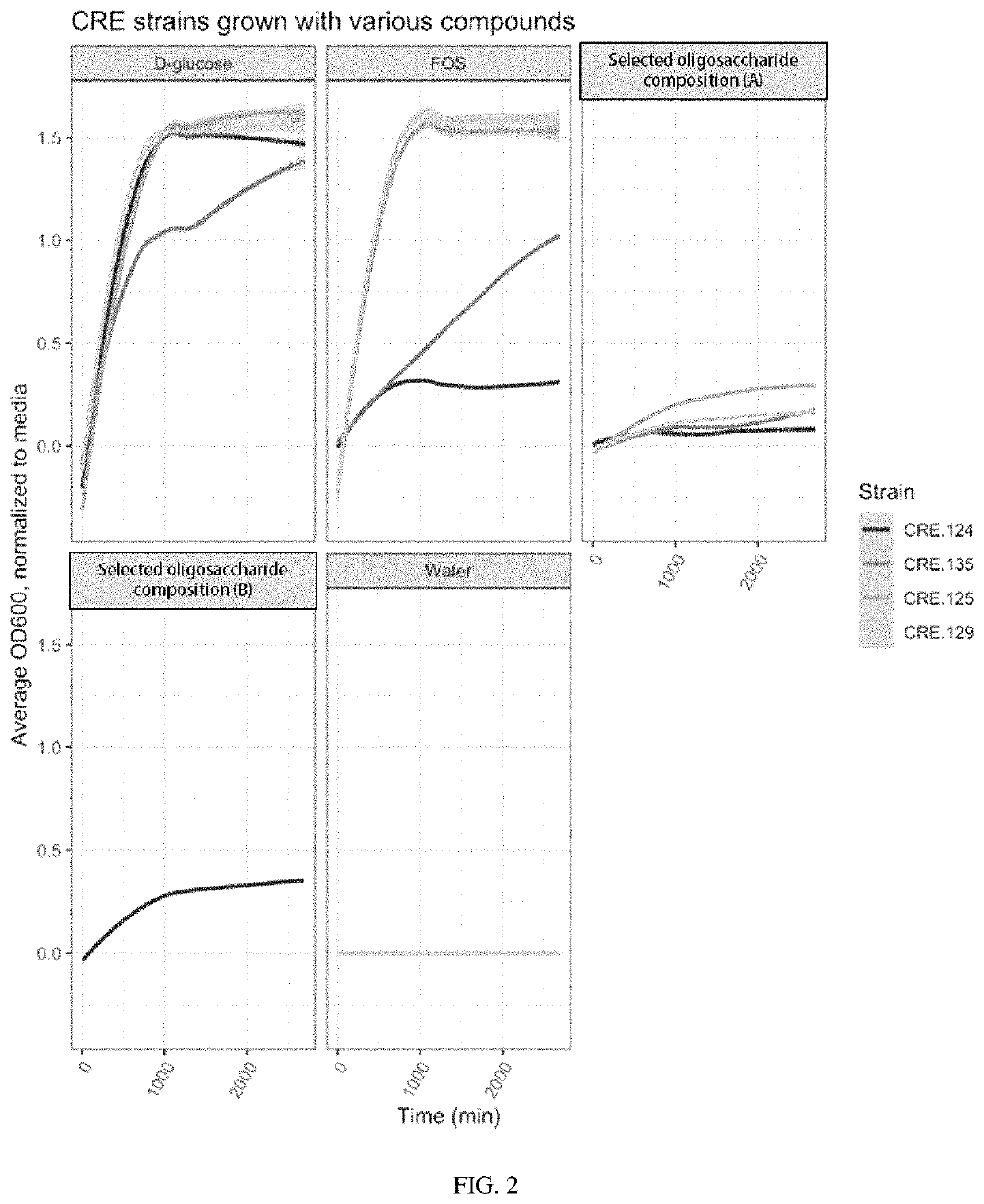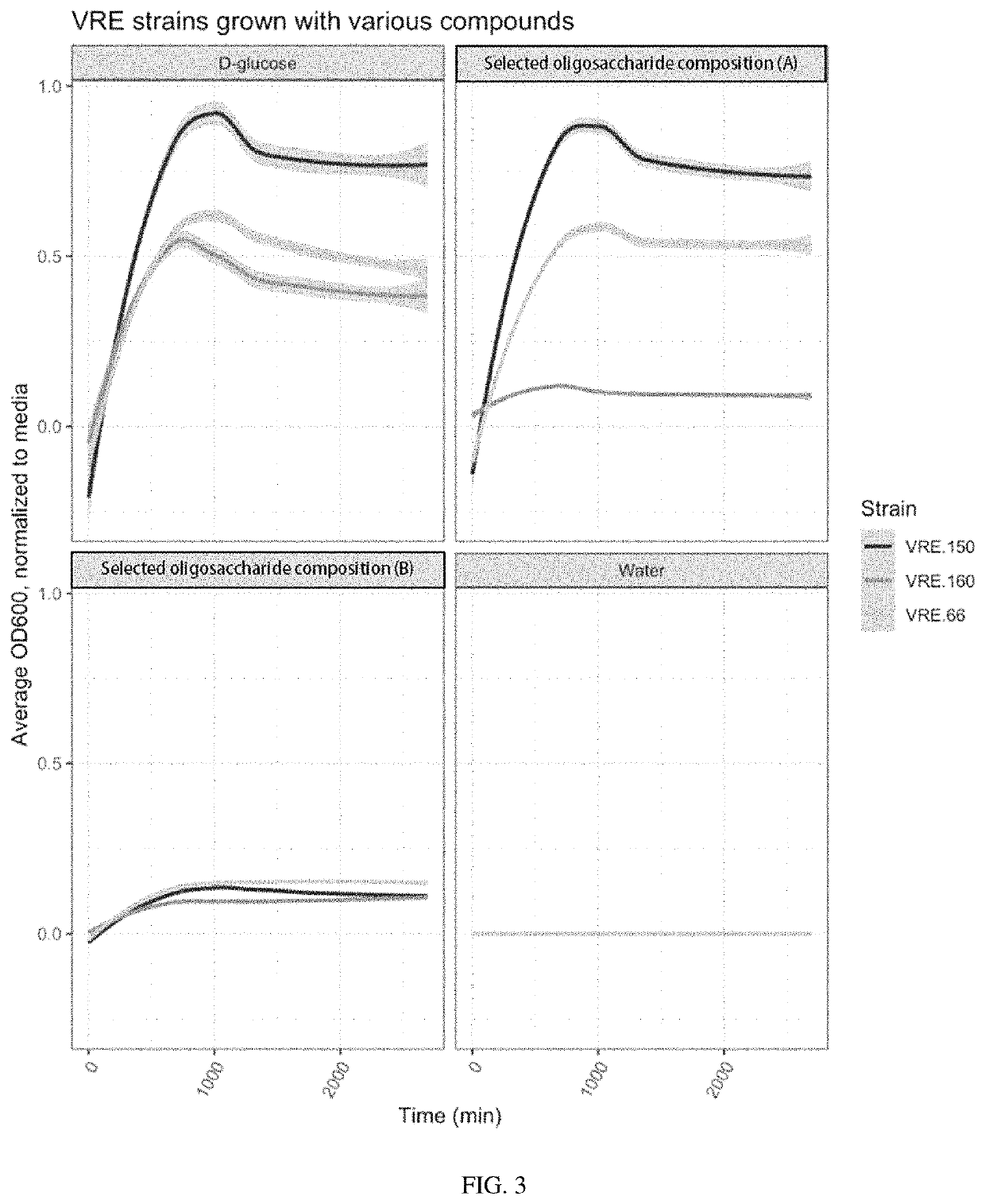Oligosaccharide compositions and methods of use thereof
a technology of oligosaccharide and composition, applied in the field of oligosaccharide composition, can solve the problems of ammonia accumulation in the gut, increased risk of infection, and serious neurological symptoms of patients, so as to improve overall health, reduce ammonia levels, and reduce the effect of acquisition
- Summary
- Abstract
- Description
- Claims
- Application Information
AI Technical Summary
Benefits of technology
Problems solved by technology
Method used
Image
Examples
example 1
n of an Exemplary Oligosaccharide Composition at 10 kg Scale from Dextrose Monohydrate and Galactose
[0486]To a reaction vessel (22 L Littleford-Day horizontal plow mixer) was added 5 kg of dextrose monohydrate, 4.5 kg of galactose and 0.892 kg (0.450 kg on a dry solid basis) of solid acid catalyst (styrene-divinylbenzene comprising sulfonic acid moieties, e.g., Dowex® Marathon® C resin). The contents were agitated at approximately 30 RPM and the vessel temperature was gradually increased over a two hour period to about 130° C. at atmospheric pressure. The mixture was maintained at temperature for one hour, after which the heating was stopped and pre-heated water was gradually added to the reaction mixture at a rate of 60 mL / min until the temperature of the reactor contents decreased to 120° C., then at a rate of 150 mL / min until the temperature of the reactor contents decreased to 110° C., then at a rate of 480 mL / min until the temperature of the reactor contents decreased below 100...
example 2
n of an Exemplary Oligosaccharide Composition at 10 kg Scale from Dextrose Monohydrate and Galactose (10 kg Scale) with Serial Catalyst Addition
[0488]The present example demonstrates the synthesis of oligosaccharide composition comprising glucose and galactose sub-units at 10 kg scale (dry oligosaccharide composition) for two replicate batches in a 22 L horizontal-mixed reactor.
[0489]About 5 kg of food grade dextrose monohydrate and 4.5 kg of food grade galactose were charged into a 22 L horizontal plough mixer (Littleford-Day, Lexington, Ky.) equipped with a hot-oil jacket. The dextrose and galactose mixture was melted by gradually heating to a temperature of about 120° C. with continuous mixing at 30 RPM. Thirty minutes later, 0.892 kg (0.450 kg on a dry solid basis) of solid acid catalyst (styrene-divinylbenzene comprising sulfonic acid moieties, e.g., Dowex® Marathon® C resin) was added to the reaction mixture to form a mixed suspension. The reaction temperature was gradually in...
example 3
n of an Exemplary Oligosaccharide Composition at 10 kg Scale from Dextrose Monohydrate and Galactose
[0491]A 22 L reactor (22 L Littleford Reactor) equipped with a condenser, oil heater (SterICo oil heater), and air-cooled chiller (Silverstar air-cooled chiller) was used in the synthesis of oligosaccharide compositions. The oil heater was set to a temperature of 300° F. and the air-cooled chiller was set to 5° C. The reactor mixing element was set to 30 Hz.
[0492]About 5.0 kg of dextrose monohydrate, 4.5 kg of anhydrous galactose, and then 0.90 kg of catalyst were sequentially added into the reactor. A condenser was attached to the top port of the reactor.
[0493]After 2.5 hours from the time the reactor began being charged with dextrose monohydrate, 6 kg of USP water were heated to 95° C. At 3 hours 10 minutes from the start of the reaction, the reactor temperature was set to 150° F. At 3 hours 15 minutes from the start of the reaction, the reaction was quenched by adding preheated wat...
PUM
 Login to View More
Login to View More Abstract
Description
Claims
Application Information
 Login to View More
Login to View More - R&D
- Intellectual Property
- Life Sciences
- Materials
- Tech Scout
- Unparalleled Data Quality
- Higher Quality Content
- 60% Fewer Hallucinations
Browse by: Latest US Patents, China's latest patents, Technical Efficacy Thesaurus, Application Domain, Technology Topic, Popular Technical Reports.
© 2025 PatSnap. All rights reserved.Legal|Privacy policy|Modern Slavery Act Transparency Statement|Sitemap|About US| Contact US: help@patsnap.com



